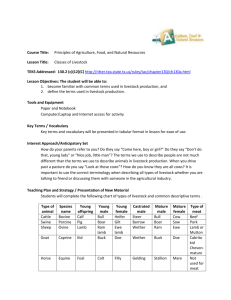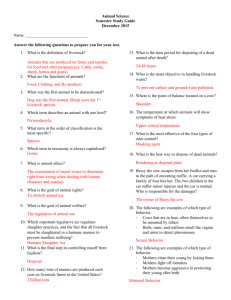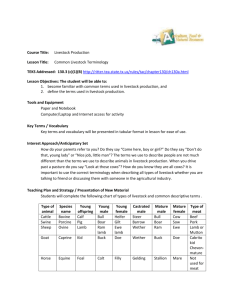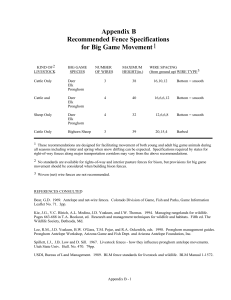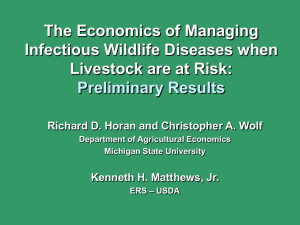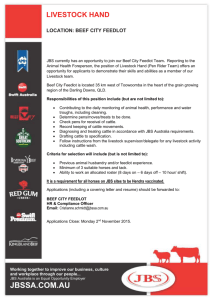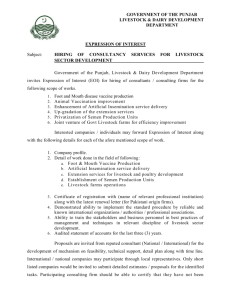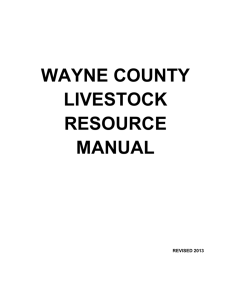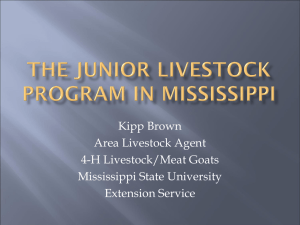Domestic Livestock and Natural Resource Stewardship
advertisement
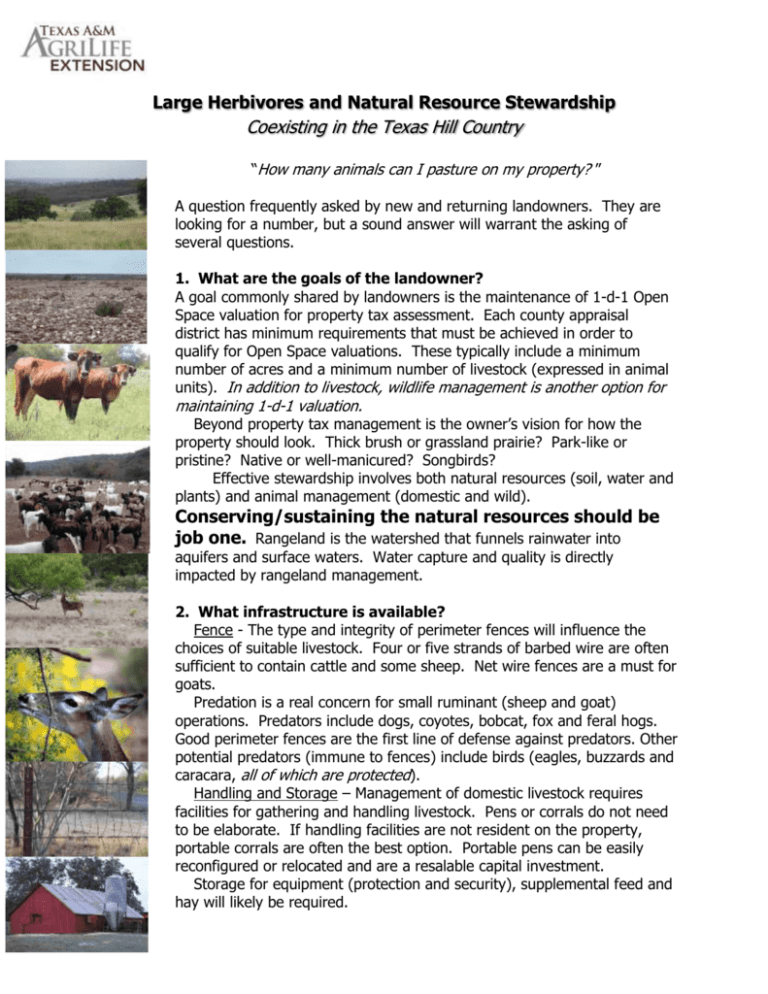
Large Herbivores and Natural Resource Stewardship Coexisting in the Texas Hill Country “How many animals can I pasture on my property? ” A question frequently asked by new and returning landowners. They are looking for a number, but a sound answer will warrant the asking of several questions. 1. What are the goals of the landowner? A goal commonly shared by landowners is the maintenance of 1-d-1 Open Space valuation for property tax assessment. Each county appraisal district has minimum requirements that must be achieved in order to qualify for Open Space valuations. These typically include a minimum number of acres and a minimum number of livestock (expressed in animal units). In addition to livestock, wildlife management is another option for maintaining 1-d-1 valuation. Beyond property tax management is the owner’s vision for how the property should look. Thick brush or grassland prairie? Park-like or pristine? Native or well-manicured? Songbirds? Effective stewardship involves both natural resources (soil, water and plants) and animal management (domestic and wild). Conserving/sustaining the natural resources should be job one. Rangeland is the watershed that funnels rainwater into aquifers and surface waters. Water capture and quality is directly impacted by rangeland management. 2. What infrastructure is available? Fence - The type and integrity of perimeter fences will influence the choices of suitable livestock. Four or five strands of barbed wire are often sufficient to contain cattle and some sheep. Net wire fences are a must for goats. Predation is a real concern for small ruminant (sheep and goat) operations. Predators include dogs, coyotes, bobcat, fox and feral hogs. Good perimeter fences are the first line of defense against predators. Other potential predators (immune to fences) include birds (eagles, buzzards and caracara, all of which are protected). Handling and Storage – Management of domestic livestock requires facilities for gathering and handling livestock. Pens or corrals do not need to be elaborate. If handling facilities are not resident on the property, portable corrals are often the best option. Portable pens can be easily reconfigured or relocated and are a resalable capital investment. Storage for equipment (protection and security), supplemental feed and hay will likely be required. 3. Which domestic herbivores are best suited to the available resources? Domestic livestock will be blended with the resident wildlife, all of which rely on the plant community for food. Domestic and wild herbivores compete for food – will they be complimentary or competitive? The answer depends on species involved. Cattle are grazers and prefer grass. Goats and deer are browsers preferring to consume leaves from trees, bushes and vines. Sheep prefer grasses and forbs (weeds) and will use some browse (if available), especially when grass and forbs are in short supply. Cattle and deer – complimentary. Goats and deer – likely competitive. Deer and deer – always competitive. The degree of competition is dictated by stock density. The key to effective stewardship is balancing forage demand with forage supply. Consider diet preferences and forages available on the property when selecting domestic livestock. Cattle are not well suited for dense juniper and steep terrain. Goats are not a best fit for monocultures of grasses. In many cases, the minimum number of livestock is not compatible with or sustainable by the minimum acreage requirements. Do not overlook the forage consumed by wildlife. The whitetail deer population has been steadily increasing since the eradication of the screwworm in the 1970’s. In addition, the ever-increasing number of introduced or ‘exotic’ wildlife (axis, *Assumes an average daily dry matter intake (expressed as percent of body weight) of 2.5% for cattle and 3.5% fallow and sika deer, blackbuck for other species listed. Forage intake is directly related antelope and numerous species of to body weight – larger animals eat more. African hoofstock) are competing with native wildlife and domestic livestock for food. The result is a reduced prevalence (or complete disappearance) of many of the preferred browse and forb species. Animal Unit Equivalents* 1 mature cow 5 mature sheep 6 mature goats 4.5 mature axis deer 7 mature whitetail deer Body weight, lbs. 1000 150 125 160 100 4. What animals and financial commitment are the owners comfortable with? Managing animals (Domestic or wild) involves financial inputs. Forage shortages due to drought, plant dormancy or overstocking are offset by reducing animal inventory (difficult to accomplish among the wild populations) or providing supplemental hay and feed. Generally profitability and hay/feed costs are inversely related. Those with minimal large animal experience may not be comfortable with cattle. People with physical or mobility limitations should exercise caution when handling or feeding livestock. Leasing the grazing rights is a viable alternative to owning livestock. For more information, contact your local Texas A&M Agrilfe County Extension Service office. http://agrilifeextension.tamu.edu/ Educational programs of the Texas A&M AgriLife Extension Service are open to all people without regard to race, color, religion, sex, national origin, age, disability, genetic information or veteran status.The Texas A&M University System, U.S. Department of Agriculture, and the County Commissioners Courts of Texas Cooperating
